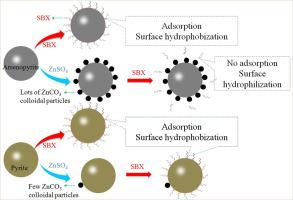Minerals Engineering ( IF 4.8 ) Pub Date : 2021-09-23 , DOI: 10.1016/j.mineng.2021.107223 Zhen Wang 1 , Jun Cao 1 , Li Wang 2 , Junhui Xiao 1 , Jinming Wang 1

|
In this study, the selective depression of arsenopyrite in pyrite flotation with in-situ generated nanoparticles was studied. Scanning electron microscope and energy dispersive X-ray spectroscopy (SEM/EDS) detection, solution chemistry analysis, fourier transform infrared spectroscopy (FTIR), adsorption tests and contact angle measurement were used to reveal the corresponding mechanism. Flotation results showed that arsenopyrite were selectively depressed and pyrite had a better flotability at pH 8.7. SEM/EDS results showed that Zn-containing nanoparticles are largely produced on arsenopyrite but rarely on the pyrite surface. Solution chemistry calculations showed that ZnCO3 nanoparticles were the major hydrophilic species at pH 7–9. This consists with the pH range where arsenopyrite was depressed. The selective generation of ZnCO3 nanoparticles on arsenopyrite surface was further confirmed by FTIR analysis. The ZnCO3 nanoparticles inhibited the adsorption of the collector onto arsenopyrite surface and made it more hydrophilic, which was suggested by the adsorption and contact angle measurement results. A model showing the selective depression mechanism of ZnSO4 on pyrite/arsenopyrite flotation system in Na2CO3 solution was also proposed. The comminution process is worth further study to clarify that whether the selective formation of ZnCO3 nanoparticles on pyrite and arsenopyrite surface is due to the difference in surface roughness.
中文翻译:

黄铁矿浮选中原位生成纳米颗粒选择性抑制毒砂
在这项研究中,研究了原位生成的纳米颗粒对黄铁矿浮选中毒砂的选择性抑制。扫描电子显微镜和能量色散X射线光谱(SEM/EDS)检测、溶液化学分析、傅立叶变换红外光谱(FTIR)、吸附试验和接触角测量被用来揭示相应的机理。浮选结果表明,毒砂在pH 8.7时被选择性抑制,黄铁矿具有更好的可浮性。SEM/EDS 结果表明,含锌纳米颗粒主要在毒砂上产生,但很少在黄铁矿表面产生。溶液化学计算表明,ZnCO 3纳米粒子是 pH 7-9 的主要亲水物质。这与毒砂被抑制的 pH 范围一致。FTIR 分析进一步证实了在毒砂表面选择性生成 ZnCO 3纳米颗粒。ZnCO 3纳米颗粒抑制了捕收剂在毒砂表面的吸附,使其更具亲水性,吸附和接触角测量结果表明了这一点。还提出了一个模型,显示了 ZnSO 4对 Na 2 CO 3溶液中黄铁矿/毒砂浮选系统的选择性抑制机制。粉碎过程值得进一步研究以阐明是否选择性形成 ZnCO 3 黄铁矿和毒砂表面上的纳米颗粒是由于表面粗糙度的差异。



























 京公网安备 11010802027423号
京公网安备 11010802027423号